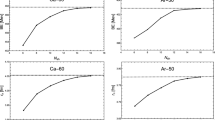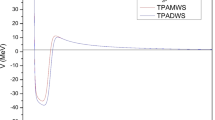Abstract
For more than 50 years after the birth of the nuclear shell model, nuclear physics seemed to be spared the trouble of confronting the fundamental issue in nuclear structure: How do the nucleon-nucleon interactions, for instance, the realistic ones constructed from nucleon-nucleon scattering data, influence or even dictate the structure of atomic nuclei? However, the observations of the evolution of shell structure in nuclei far from the stability line expose the need to understand the effects of the nucleon-nucleon interactions. The successful measurements of high-momentum nucleons from correlated nucleon pairs, which arise naturally from the nucleon-nucleon interactions such as the tensor interactions, in nuclei suggest the possibility to study their effects. Here, we report on experimental evidence for the \(Z=6\) subshell closure in neutron-rich carbon isotopes and observations of the effect of tensor interactions in \(^{16}\)O via high-momentum-transfer neutron picked-up reactions. Providing a brief summary of the recent developments, we introduce our future plans to study the effect of tensor interactions on the shell evolution.




Similar content being viewed by others
Notes
Unless otherwise stated, the short-range interactions are referred to as the repulsive hard-core interactions in this paper.
References
H. Yukawa, On the interaction of elementary particles I. Proc. Phys. Math. Soc. Jpn. 17, 48 (1935)
N. Kemmer, Nature of the nuclear field. Nature 141, 116 (1938)
H. Yukawa, S. Sakata, M. Taketani, On the interaction of elementary particles III. Proc. Phys. Math. Soc. Jpn. 20, 319 (1935)
M. Goeppert-Mayer, On closed shells in nuclei II. Phys. Rev. 75, 1969 (1949)
O. Haxel, J.H.D. Jensen, H.E. Suess, On the “magic numbers” in nuclear structure. Phys. Rev. 75, 1766 (1949)
O. Sorlin, M.-G. Porquet, Nuclear magic numbers: new features far from stability. Prog. Part. Nucl. Phys. 61, 602 (2008)
T. Otsuka, T. Suzuki et al., Evolution of nuclear shells due to the tensor force. Phys. Rev. Lett. 95, 232502 (2005)
S.C. Pieper, V.R. Pandharipande, Origins of spin-orbit splitting in 15 N. Phys. Rev. Lett. 70, 2541 (1993)
R. Schiavilla, R.B. Wiringa, S.C. Pieper, J. Carlson, Tensor forces and the ground-state structure of nuclei. Phys. Rev. Lett. 98, 132501 (2007)
T. Neff, H. Feldmeier, Tensor correlations in the unitary correlation operator method. Nucl. Phys. A 713, 311 (2003)
D.T. Tran, H.J. Ong et al., Evidence for prevalent \(Z=6\) magic number in neutron-rich carbon isotopes. Nat. Commun. 9, 1594 (2018)
H.J. Ong, I. Tanihata et al., Probing effect of tensor interactions in 16 O via (p, d) reaction. Phys. Lett. B 725, 277 (2013)
S. Terashima, L. Yu et al., Dominance of tensor correlations in high-momentum nucleon pairs studied by (p, pd) Reaction. Phys. Rev. Lett. 121, 242501 (2018)
M. Goeppert-Mayer, The shell model. Physics 20, 1679 (1963)
Y. Fujiwara, H. Horiuchi et al., Comprehensive study of alpha-nuclei. Prog. Theor. Phys. Suppl. 68, 29 (1980)
W. von Oertzen, Dimers based on the \(\alpha +\alpha \) potential and chain states of carbon isotopes. Z. Phys. A 357, 355 (1997)
T. Suhara, Y. Kanada-En’yo, Effects of \(\alpha \)-cluster breaking on \(3\alpha \)-cluster structures in \(^{12}\)C. Phys. Rev. C 91, 024315 (2015)
B.A. Brown, The nuclear shell model towards the drip lines. Prog. Part. Nucl. Phys. 47, 517 (2001)
N. Imai, H.J. Ong et al., Anomalously hindered \(E2\) strength \(B(E2;2_1^+\rightarrow 0_{{\rm gs}}^+)\) in \(^{16}\text{ C }\). Phys. Rev. Lett. 92, 062501 (2004)
M. Wiedeking, P. Fallon et al., Lifetime measurement of the first excited \(2^+\) state in \(^{16}\text{ C }\). Phys. Rev. Lett. 100, 152501 (2008)
H.J. Ong, N. Imai et al., Lifetime measurements of first excited states in \(^{16,18}\text{ C }\). Phys. Rev. C 78, 014308 (2008)
R. Fujimoto, Shell Model Description of Light Unstable Nuclei (The University of Tokyo, Tokyo, 2003)
T. Shimoda, H. Miyatake, S. Morinobu, Design study of the secondary-beam line at RCNP. Nucl. Instrum. Methods B 70, 320 (1992)
H.J. Ong, Nuclear physics frontier at RCNP. AIP Conf. Proc. 1588, 146 (2014)
D.T. Tran, H.J. Ong et al., Charge-changing cross-section measurements of \(^{12-16}\text{ C }\) at around \(45A\) MeV and development of a Glauber model for incident energies \(10A\)-\(2100A\) MeV. Phys. Rev. C 94, 064604 (2016)
S. Terashima, I. Tanihata et al., Proton radius of 14 Be from measurement of charge-changing cross sections. Prog. Theor. Exp. Phys 101D02(2014)
A. Estrade, R. Kanungo et al., Proton radii of \(^{12-17}\text{ B }\) define a thick neutron surface in \(^{17}\text{ B }\). Phys. Rev. Lett. 113, 132501 (2014)
R. Kanungo, W. Horiuchi et al., Proton distribution radii of \(^{12-19}\text{ C }\) illuminate features of neutron halos. Phys. Rev. Lett. 117, 102501 (2016)
A. Ekstrom, G.R. Jansen et al., Accurate nuclear radii and binding energies from chiral interaction. Phys. Rev. C 91, 051301(R) (2015)
A. Ekstrom, G. Baardsen et al., Optimized chiral nucleon-nucleon interaction at next-to-next-to-leading order. Phys. Rev. Lett. 110, 192502 (2013)
I. Angeli, K.P. Marinova, Table of experimental nuclear ground state charge radii: an update. At. Data Nucl. Data Tables 99, 69 (2013)
B. Pritychenko, M. Birch, B. Singh, M. Horoi, Tables of \(E2\) transition probabilities from the first \(2^+\) states in even-even nuclei. At. Data Nucl. Data Tables 107, 1 (2016)
M. Wang, G. Audi et al., The AME2016 atomic mass evaluation. Chin. Phys. C 41, 030003 (2017)
H.R. Collard, L.R.B. Elton, R. Hofstadter, Nuclear Radii 2 (Springer, Berlin, 1967)
E. Piasetzky, M. Sargsian et al., Evidence for strong dominance of proton-neutron correlations in nuclei. Phys. Rev. Lett. 97, 162504 (2006)
R. Subedi, R. Shneor et al., Probing cold dense nuclear matter. Science 320, 1476 (2008)
O. Hen, G.A. Miller, E. Piasetzky, L.B. Weinstein, Nucleon-nucleon correlations, short-lived excitations and the quarks within. Rev. Mod. Phys. 89, 045002 (2017)
M. Duer, O. Hen et al., Probing high-momentum protons and neutrons in neutron-rich nuclei. Nature 560, 617 (2018)
J.L. Snelgrove, E. Kashy, Phys. Rev. 187, 1246 (1969)
M. Fujiwara, H. Akimune et al., Magnetic spectrometer Grand Raiden. Nucl. Instrum. Methods A 422, 484 (1999)
P.G. Roos, S.M. Smith et al., Nucl. Phys. A 255, 187 (1975)
J.K.P. Lee, S.K. Mark et al., Nucl. Phys. A 106, 357 (1968)
R. Abegg, D.A. Hutcheon et al., Phys. Rev. C 39, 65 (1989)
G.R. Smith, J.R. Shepard et al., Phys. Rev. C 30, 593 (1984)
M. Yahiro, K. Ogata et al., Prog. Theo. Exp. Phys. 01A206, 196 (2012)
T. Myo, S. Sugimoto et al., Prog. Theo. Phys. 117, 257 (2007)
C.L. Guo, Probing effects of tensor interactions in nuclei via \(^{16}\)O and \(^{12}\)C(p, d) reaction, PhD thesis, Beihang Univ. (2016); X. Wang, Studying the high-momentum neutron in nuclei by \(^{16}\)O(p,d) transfer reactions—Search for the effect of tensor interactions, Master’s Thesis, Osaka University (2020); X. Wang, H. J. Ong et al., in preparation
L. Yu, S. Terashima et al., Multi-layer plastic scintillation detector for intermediate- and high-energy neutrons with n-\(\gamma \) discrimination capability. Nucl. Instrum. Methods A 866, 118 (2017)
T. Neff, H. Feldmeier, W. Horiuchi, Short-range correlations in nuclei with similarity renormalization group transformations. Phys. Rev. C 92, 024003 (2015)
S. Cohen, D. Kurath, Two-nucleon transfer in the 1\(p\) shell. Nucl. Phys. A 141, 145 (1970)
J.Y. Grossiord, M. Bedjidian et al., (p, pd), (p, pt) and (\(\text{ p },\text{ p}^3\text{ He }\)) reactions on \(^{12}\text{ C }\) and \(^{16}\text{ O }\) at 75 MeV. Phys. Rev. C 15, 843 (1977)
J.C. Yang, J.W. Xia et al., High Intensity heavy ion Accelerator Facility (HIAF) in China. Nucl. Instrum. Methods B 317, 263 (2013)
H. Geissel, H. Weick et al., The Super-FRS project at GSI. Nucl. Instrum. Methods B 204, 71 (2013)
Acknowledgements
The author thanks the collaborators of the RCNP-E314, GSI-S395, RCNP-E372, RCNP-E396, RCNP-E443, GSI-S436 and CYRIC-134-930-15 experiments.
Author information
Authors and Affiliations
Corresponding author
Additional information
Publisher's Note
Springer Nature remains neutral with regard to jurisdictional claims in published maps and institutional affiliations.
Rights and permissions
About this article
Cite this article
Ong, H.J. Understanding Effect of Tensor Interactions on Structure of Light Atomic Nuclei. Few-Body Syst 62, 86 (2021). https://doi.org/10.1007/s00601-021-01668-3
Received:
Accepted:
Published:
DOI: https://doi.org/10.1007/s00601-021-01668-3




